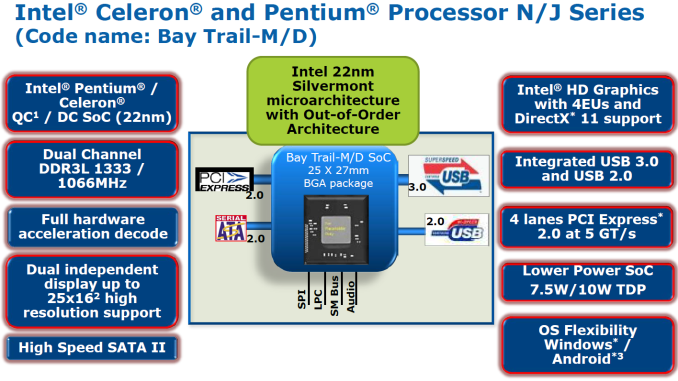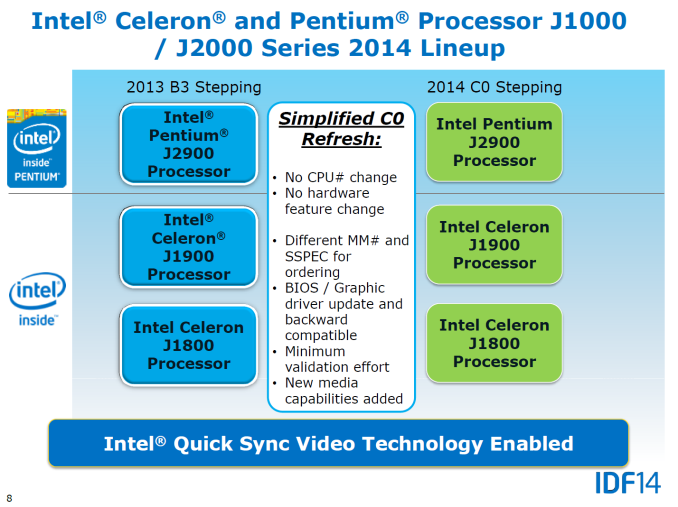QNAP TS-x51 NAS Series: Intel Quick Sync Gets its Killer App
by Ganesh T S on June 22, 2014 6:45 PM ESTQNAP Goes Bay Trail
Intel's Bay Trail-D takes the original Bay Trail configuration pretty much as-is. One of Intel's marketing slides for Bay Trail-D (and -M) is reproduced below for aiding our analysis.
Despite not being specifically mentioned, we know there are two SATA II (3 Gbps) ports in Bay Trail-D from the previous section. Combined with the four PCIe 2.0 lanes, the configuration is pretty much similar to the Atom D2700 along with a NM10 chipset in terms of I/O. The advantage is that all the high-speed I/Os come direct from the SoC and are not bottlenecked by DMI lanes, and the PCIe revision is 2.0 instead of 1.0. In addition, we also have a USB 3.0 port.
The Celeron J1800 used in the TS-x51 is a 2C/2T solution with a base frequency of 2.41 GHz and a burst speed of 2.58 GHz. With a 10W TDP, it is amenable to passive cooling with the appropriate chassis, but, in a NAS like the x51, it is a moot point since the drives require cooling anyway. The TS-x51 series comes in 2,4,6 and 8-bay varieties and all of them come with two GbE ports. While the 2 and 4-bay varieties come with 2x USB 3.0 ports, the 6 and 8-bay ones come with 3x USB 3.0 ports. Based on the above information, we can infer the following distribution of the high-speed interfaces amongst the various I/Os.
| QNAP TS-x51 Series High-Speed I/O Usage [ UPDATED ] | ||||
| SoC I/O | TS-251 | TS-451 | TS-651 | TS-851 |
| PCIe 2.0 x1 | GbE Port 1 | GbE Port 1 | GbE Port 1 | GbE Port 1 |
| PCIe 2.0 x1 | GbE Port 2 | GbE Port 2 | GbE Port 2 | GbE Port 2 |
| USB 3.0 x1 | 2x USB 3.0 (Hub) | 2x USB 3.0 (Hub) | 3x USB 3.0 (Hub) | 3x USB 3.0 (Hub) |
| PCIe 2.0 x2 | Free for Drive Bays | |||
| SATA II x2 | ||||
While the 2-bay unit is capable of having probably all I/Os accessible through the SoC fabric at full speeds, the 4-,6- and 8-bay varieties need some trade-offs. [Update: QNAP confirmed that they are using a USB 3.0 hub chip as one of the commenters pointed out]. In the above table, we see that two PCIe 2.0 lanes and two SATA II (3 Gbps) lanes are available for connecting all the drives in the bays to the SoC. In the absence of a I/O Controller Hub (that made the previous generations of Atom-based NAS units simple to design), each vendor is now free to choose between a number of different available options.
An issue with the Celeron J1800 (and Bay Trail-D in general) is that the SATA ports don't support port multipliers. In addition, there is only one SATA controller behind the two SATA ports. This places undue stress on the two free PCIe link to service a large number of bays. Our educated guess is that QNAP uses a number of PCIe to SATA bridges (such as the Marvell 88SE9130 and the ASMedia ASM1061 for PCIe x1 to 2x SATA and Marvell 88SE9215 for PCIe x1 to 4x SATA). This still doesn't explain how the TS-851 is configured (I am yet to see a PCIe x1 to 6x SATA bridge chip). It will be interesting to see the break-up, but, at this moment, QNAP has not got back with answers to our clarification requests. The addition of two USB 3.0 ports to the 6- and 8-bay models actually takes away a PCIe x1 lane that could have otherwise been used for the drive bays. I am not sure how many users need more than one USB 3.0 slot in a NAS.
Update: QNAP came forward with clarifications on the I/O distribution:
- TS-251: 1x ASM1061 (i.e, two SATA ports are served by one PCIe link)
- TS-451: 2x ASM1061 (four SATA ports from two PCIe links)
- TS-651: 2x 88SE9215 (three SATA ports per PCIe link)
- TS-851: 2x 88SE9215 (four SATA ports per PCIe link)
Coming back to the Celeron J1800 SoC, the two features most relevant to us in this piece are the availability of Quick Sync (something not claimed in the initial Bay Trail launch) and VT-x (support for virtualization). We will be covering this in the next two sections. Prior to that, a quick note on the J1800 which has both 2013 B3 as well as 2014 C0 steppings. Intel started playing up the Quick Sync capabilities of the Bay Trail-D / Bay Trail-M parts for products which are part of the push for the 'Back-to-School 2014' season.
It appears from the above slide that only the 2014 C0 steppings of the J1800 have QuickSync enabled (we are still waiting for confirmation from Intel on this). Since the hardware accelerated transcoding features of the TS-x51 are dependent on Quick Sync, it is obvious that the TS-x51 must be using the C0 stepping of the Celeron J1800.












49 Comments
View All Comments
rikm - Sunday, June 22, 2014 - link
the slide says "All new tubro" , kind of like turbo, but not quite that fast?wintermute000 - Sunday, June 22, 2014 - link
look forward to benches + real world transcoding testing.In particular want to see if everything is covered or there are any notable exceptions in terms of codec/container
SilthDraeth - Sunday, June 22, 2014 - link
Tubro, faster than snailro, just barely.ganeshts - Monday, June 23, 2014 - link
Didn't see that typo in their marketing brochure, to be honest :)Just spent some time fixing up the image at my end, so it should be OK now.
[-Stash-] - Monday, June 23, 2014 - link
Quick, hit the Turbo Button!steveoat - Sunday, June 22, 2014 - link
Looks interesting. What will be the costs of the 4 and 6 bay units?DanNeely - Sunday, June 22, 2014 - link
Probably similar to that of their current x69 series which are $540/712 for the bay and $782/925 for the 6 bay models on Amazon depending on if you go with the L or Pro models.Skarn - Sunday, June 22, 2014 - link
I'll be looking forward to seeing a full review of these units once samples become available. I'd especially like to know if the GPU driver baked in to drive the HDMI port fix the tearing problems I've seen on Sandy Bridge GPUs. While the feature set is sufficient that I'd be interested in these units despite this issue, I find tearing quite bothersome. I'd also be interested in seeing a full list of supported video codecs.ganeshts - Monday, June 23, 2014 - link
I wouldn't hold my hopes too high.. Intel GPUs' Linux drivers for video playback have historically been 'unreliable'. (That is why I wasn't too enthused about XBMC and HDMI output on the Evansport-based NAS units from Thecus and Asustor).That said, the list of supported codecs for transcoding input would definitely be something to evaluate and look into in greater details.
haardrr - Monday, June 23, 2014 - link
the latest intel drivers for linux 14.04 are amazing... (at least for the mythtv)...i know mythtv is NOT the same as a NAS box...
BUT, if the OS on this NAS is 14.04 (or similiar) you should not have any of the problems you have described.